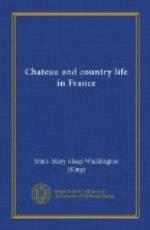However, the effect, with all the bright colouring, is very good and quite in harmony with this part of the country, where everything teems with legends and traditions of the great Duke. They see Falaise, where he was born, from their terrace, sometimes. We didn’t, for though the day was beautiful, there was a slight haze which made the far-off landscapes only a blue line.
After breakfast we went for a walk in the park. They have arranged it very well, with rustic bridges and seats wherever the view was particularly fine. We saw a nice, old, red brick house, near the farm, which was the manoir where the Dowager Countess lives now. She made over the chateau to her son, in her life time, on condition that he would keep it up and arrange it, which he has done very well. We made the tour of the park—passing a pretty lodge with roses and creepers all over it and “Mairie” put upon a sign; d’Y——is mayor of his little village and finds it convenient to have the Mairie at his own gate. We rested a little in the drawing-room before going back, and he showed us various portraits and miniatures of his family which were most interesting. Some of the miniatures are exactly like one we have of father, of that period with the high stock and tight-buttoned coat. The light was lovely—so soft and warm—in the drawing-room, and as there were no lace curtains or vitrages, and the silk curtains were drawn back from the high plate glass windows, we seemed to be sitting in the park under the trees. They gave us tea and the good little cakes, “St. Pierre,” a sort of “sable,” for which all the coast is famous.
The drive home was enchanting, with a lovely view from the top of the hill; a beautiful blue sea at our feet and the turrets and pointed roofs of the Villers houses taking every possible colour from the sunset clouds.




